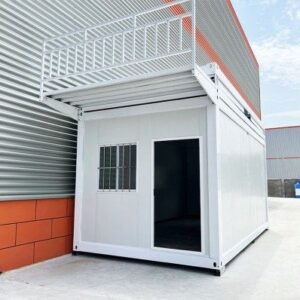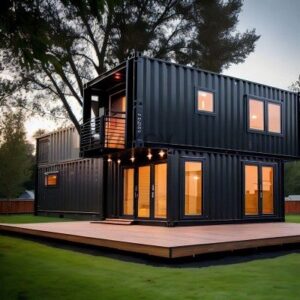Thinking about investing in a container house but wondering, how long does a container house last? You’re not alone. Durability is a major factor when considering these innovative homes made from shipping containers. From rust resistance to structural strength, understanding their lifespan is key to making a smart investment. In this guide, you’ll discover the real-world longevity of container homes, what affects their durability, and how you can ensure your container house stands strong for decades. Let’s get straight to the facts you need to know!
Container Houses What Are They Made Of
Shipping container houses are built from shipping containers originally designed for freight transport. These containers are primarily made of Corten steel, a weathering steel known for its exceptional strength and corrosion resistance. This makes them highly durable, able to withstand harsh sea conditions, heavy stacking, and rough handling during shipping.
In their original use, shipping containers are engineered to protect goods from moisture, saltwater, and physical impact. This inherent structural integrity and weatherproofing means the steel shell is much tougher than traditional building materials like wood or brick when it comes to resisting external forces.
When repurposed into homes, however, the lifespan of a shipping container can be affected by changes in use and environment. Cutting openings for windows and doors, welding modifications, and exposure to new climates can introduce vulnerabilities like rust or structural weaknesses if not properly managed. Additionally, without proper insulation and protective coatings, containers may experience condensation and corrosion faster than in their original shipping environment.
Despite these challenges, with quality materials and thoughtful construction, a container house can retain much of the robustness that shipping containers are known for, providing a strong foundation for long-lasting, sustainable homes. For detailed design and build approaches to maximize durability, check out prefabricated container house options.
Typical Lifespan of a Container House
Container homes typically last between 25 to 50 years or more, depending on several factors like maintenance, materials, and environment. When new or well-maintained, steel shipping containers offer excellent durability because they were originally built to withstand harsh conditions during freight shipping.
How Container Home Lifespan Compares to Traditional Homes
| Home Type | Average Lifespan | Notes |
|---|---|---|
| Container House | 25–50+ years | Can last longer with proper care and upgrades |
| Wood Frame Home | 30–50 years | Susceptible to rot, pests, and weather |
| Brick Home | 50–100 years | Requires less maintenance but can crack |
| Concrete Home | 50–100+ years | Extremely durable, low maintenance |
Compared to wood or brick homes, container homes offer comparable lifespans especially when protected against rust and corrosion. They excel in structural integrity, but unlike traditional homes, steel containers need regular rust prevention.
Real-World Examples of Longevity
- Some container buildings used in industrial settings have lasted over 50 years with routine maintenance.
- Residential container homes built in the last 20 years show no significant wear when maintained well.
- In coastal or humid areas, lifespan may be closer to the lower end unless corrosion is properly managed.
Overall, the potential for long-lasting durability is there, making container homes a viable long-term housing option when built and maintained right.
Key Factors That Influence the Longevity of Container Homes
The lifespan of container homes depends on several important factors. Understanding these helps you get the most out of your shipping container house.
Material Quality and Container Type
Whether your container home is made from new or used shipping containers plays a big role. New containers generally offer better corrosion resistance and structural integrity. Used containers can still last a long time if properly inspected and refurbished, but they may come with hidden wear or rust that shortens their lifespan.
Environmental Conditions
Where you place your container home matters. Humidity, coastal proximity, and temperature swings impact how fast rust and deterioration set in.
- High humidity and coastal areas expose containers to salt and moisture, increasing corrosion risk.
- Extreme temperature changes cause steel to expand and contract, potentially stressing welds and seals.
Choosing the right location or adding protective features can help your container home last longer.
Maintenance Practices
Ongoing maintenance is a must to prevent common problems like rust and water damage.
Key upkeep tasks include:
- Regular painting and rust prevention treatments
- Proper waterproofing to keep moisture out
- Routine inspections for damage or corrosion
Neglecting these can drastically reduce your container house’s lifespan.
Construction Quality and Insulation
How your container home is built also affects durability. Quality construction and well-done insulation help prevent internal moisture build-up and structural issues.
- Proper welding and structural reinforcement maintain the container’s strength.
- Good insulation and ventilation reduce condensation, mold risk, and temperature swings inside the home.
Foundation and Structural Enhancements
A solid foundation and extra supports can make a big difference. A properly laid foundation prevents settling or shifting that could warp or damage the container frame. Adding reinforcements where walls are cut or modified keeps the home structurally sound for decades.
Common Issues That Can Shorten Container House Lifespan
When thinking about container home lifespan, it’s important to understand what factors can reduce durability and longevity. Here are some of the most common problems that container houses face:
Corrosion and Rust Problems
Shipping containers are made from corten steel which resists rust initially, but once the protective layer wears off or is damaged, corrosion can set in quickly. This is especially true if the container is exposed to humid, coastal, or rainy environments without proper maintenance.
- Rust weakens the steel frame, compromising structural integrity.
- Poor or infrequent rust prevention measures like painting and sealing accelerate decay.
- Areas with scratches or weld modifications are particularly vulnerable.
Structural Damage from Modifications or Poor Construction
Container houses often undergo significant modifications to add doors, windows, and insulation. If these changes are not done right, they can:
- Weaken the container’s original frame and load-bearing ability.
- Cause cracks or warping from improper welding or cutting.
- Lead to uneven stress distribution resulting in shorter overall lifespan.
Choosing experienced builders and following proper construction methods is key to avoiding these issues.
Moisture Infiltration and Mold
Containers were built for cargo, not living spaces, so without proper insulation and waterproofing, moisture can get inside:
- Leaks lead to rust from the inside out.
- Trapped moisture causes mold and mildew, which damage interior materials and harm indoor air quality.
- Poor ventilation worsens moisture buildup and accelerates material degradation.
Foundation Settling and Movement
A solid foundation is crucial for container homes. If the foundation shifts, settles, or cracks, it affects:
- The structural stability of the entire container.
- Alignment of doors and windows, causing gaps where moisture and pests enter.
- Overall lifespan through increased stress on walls and supports.
Proper site assessment and foundation work help prevent this common issue.
How to Maximize the Lifespan of Your Container House
To extend the durability of your container home, regular upkeep is essential. Here’s how to make your shipping container house last longer and stay in great shape:
Schedule Regular Maintenance and Inspections
Set up a maintenance routine to:
- Inspect the structure for any signs of rust or corrosion
- Check seals, windows, and doors for leaks
- Repaint areas where the coating is wearing thin to protect the steel
Use Protective Coatings and Rust Treatments
Apply high-quality rust inhibitors and protective paints designed for steel containers. These coatings prevent corrosion and add an extra layer of defense against harsh weather, especially in humid or coastal areas known to accelerate rust.
Design to Minimize Damage Risks
Smart design choices can reduce wear and tear, such as:
- Avoiding unnecessary cutting or welding that can weaken the steel shell
- Incorporating overhangs or awnings to shield exterior walls from rain and sun
- Using properly sealed and weatherproof doors and windows
Install Proper Insulation and Ventilation
Good insulation helps control temperature swings, while ventilation prevents moisture buildup inside the container. Managing humidity is key to stopping mold and rust, which are common issues in container homes without adequate airflow.
Choose Certified Containers and Skilled Builders
Starting with high-quality, certified containers (new or well-maintained used units) gives you a better foundation. Also, working with experienced builders like yichen ensures your container home is constructed with attention to structural integrity and long-term durability.
By following these steps, you can effectively increase the lifespan of your container house, making it a reliable and lasting home option for years to come.
Real Life Examples of Container House Lifespan and Durability
When you wonder how long does a container house last, it helps to look at real-world examples. Many container homes have outlasted expectations, especially those built with quality materials and proper maintenance. Some repurposed shipping containers used for housing have been standing strong for decades, showing impressive durability over time.
At Yichen, we’ve worked on multiple projects where container homes have lasted 25 years or more with minimal issues. Our clients often share stories that highlight how the strength of Corten steel containers combined with quality construction practices leads to long-lasting homes. For instance, one of our projects in coastal California has remained structurally sound through salty air and heavy rain for over 20 years, thanks to enhanced rust protection and smart design choices.
Testimonials from Yichen Projects
- Long lasting structure: “Our container home has been solid for over 15 years with very little upkeep. The rust-preventive coatings Yichen used have really made a difference.”
- Weather resilience: “Living in a coastal area, we were worried about corrosion. Yichen’s design and maintenance plan have kept our home intact without major repairs for 18 years.”
- Energy efficient and durable: “The insulation and ventilation Yichen installed not only keep the house comfortable but also protect the steel from moisture damage, extending the house’s life.”
These examples reflect the potential lifespan of container homes when built and cared for properly. Choosing experienced builders like Yichen ensures you get a container house that not only meets your design needs but also stands the test of time.
By trusting certified and quality container materials plus professional maintenance advice, your shipping container house can be a reliable, long-term home solution.
Warranty and Insurance for Container Homes Longevity
When it comes to the lifespan of a container house, knowing the warranty details and insurance options is key to protecting your investment.
Typical Warranty Coverage Times for Container Homes
Most container homes come with warranties that cover structural components for 10 to 25 years—this varies depending on the builder and container quality. For example, new or certified containers often have longer warranty periods compared to used shipping containers, which might come with limited or no warranty. It’s common for custom builders like Yichen to offer warranties on:
- Frame integrity
- Roof and wall structure
- Major modifications like cutting and welding
Keep in mind, warranties usually require you to maintain the home properly, including rust prevention and regular inspections.
What Insurance Providers Consider for Container Home Longevity
Getting insurance for a container home isn’t always straightforward because some insurers treat them differently from traditional homes. Here’s what they look at:
- Construction quality: Insurers prefer container homes built by experienced professionals, with proper insulation and waterproofing.
- Permanent foundation: Homes with solid foundations get better coverage prospects.
- Location: Coastal or humid areas may pose higher risks for rust or corrosion—insurance providers factor this in.
- Maintenance records: Regular upkeep—particularly rust prevention and moisture control—can positively affect insurance terms.
- Compliance with building codes: Homes that meet or exceed local codes increase chances for favorable insurance coverage.
In many cases, standard homeowners insurance can cover container homes if they qualify as permanent buildings. However, specialized policies might be necessary for unique features or risks associated with container structures.
- Warranty coverage usually lasts 10-25 years but depends on container type and builder.
- Insurers focus on build quality, foundation, location risks, and maintenance history.
- Proper documentation and using trusted builders like Yichen can ease insurance and warranty concerns.
This approach helps ensure your container home’s durability is backed by solid protection, extending its real-world lifespan and value.
Final Thoughts on Container House Lifespan and Long-Term Use
Container houses can be a solid long-term housing solution, but their durability depends on several important factors. The lifespan of container homes typically ranges from 25 to 50 years or more, especially when built with quality materials and properly maintained. Compared to traditional homes made from wood, brick, or concrete, container houses can offer similar longevity, with the added benefits of faster construction and often lower costs.
Benefits Versus Longevity Concerns
- Durability: Shipping containers are built with tough Corten steel designed to withstand harsh conditions during freight shipping. This provides a strong foundation for container homes.
- Versatility: With proper insulation, waterproofing, and structural modifications, container homes can handle various climates found across the U.S., including humid, coastal, or cold areas.
- Maintenance Needs: The biggest concerns around lifespan involve potential rusting, corrosion, and moisture damage. These risks can be minimized with regular upkeep and protective coatings.
- Customization: Modifying containers without compromising their structural integrity is critical. Poor alterations can shorten lifespan, so experienced builders like Yichen play a key role in maximizing durability.
When Container Homes Excel
Container homes are especially durable and practical in these situations:
- Urban and remote locations where quick, modular construction is needed.
- Areas with challenging terrain where traditional building is costly or difficult.
- Sustainable living projects focused on reusing materials responsibly.
Consulting Professionals for Longevity
To get the best lifespan and performance from a container house, work with professionals like Yichen who specialize in container home construction. They understand how to:
- Select high-quality, corrosion-resistant containers.
- Implement solid foundations and weatherproofing.
- Ensure proper insulation and ventilation to prevent moisture problems.
- Navigate local building codes and warranty options.
Taking these steps will help ensure your container home remains resilient, comfortable, and valuable for decades to come



